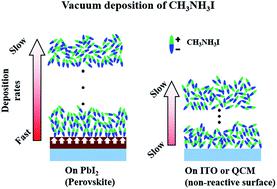当前位置:
X-MOL 学术
›
Nanoscale Adv.
›
论文详情
Our official English website, www.x-mol.net, welcomes your feedback! (Note: you will need to create a separate account there.)
Growth mechanism of CH3NH3I in a vacuum processed perovskite
Nanoscale Advances ( IF 4.7 ) Pub Date : 2020-07-24 , DOI: 10.1039/d0na00466a Beom-Soo Kim 1 , Yoonjay Han 1 , Jang-Joo Kim 1, 2
Nanoscale Advances ( IF 4.7 ) Pub Date : 2020-07-24 , DOI: 10.1039/d0na00466a Beom-Soo Kim 1 , Yoonjay Han 1 , Jang-Joo Kim 1, 2
Affiliation

|
In the field of halide perovskite research, the growth of high quality films has been a critical issue. Among the reported growth methods, vacuum processes have attracted much attention due to their accurate controllability and high reproducibility, as proven in the manufacture of vacuum deposited organic-light-emitting-diode industry. In a vacuum process, the major difficulty for growing a perovskite film is control of a precursor, methylammonium iodide (MAI), originating from its uncontrollable behavior i.e., a high working pressure and poor adsorption characteristics. Thus, it is crucial to understand the growth mechanism of MAI vapor for the successful application of vacuum processes in the growth of halide perovskite films. In this paper, we report the growth mechanism and deposition kinetics of MAI in a vacuum. Unlike that of conventional materials evaporated in a vacuum, the deposition rate of MAI was found to be much faster on the reactive surface, PbI2, compared to other non-reactive materials. Surprisingly, a very thin (2 nm-thick) PbI2 layer increased the initial growth rate of MAI 2.7-fold. Based on the real-time monitored data from a quartz microbalance and surface study, we suggest dipole-induced adsorption as the MAI growth mechanism on PbI2 and the perovskite in the vacuum process. We believe that this work will provide meaningful insight into film growth in vacuum processed perovskites.
中文翻译:

CH3NH3I在真空处理钙钛矿中的生长机理
在卤化物钙钛矿研究领域,高质量薄膜的生长一直是一个关键问题。在已报道的生长方法中,真空工艺因其精确的可控性和高重现性而备受关注,这在真空沉积有机发光二极管行业的制造中得到了证明。在真空工艺中,生长钙钛矿薄膜的主要困难是控制前体甲基碘化铵 (MAI),这源于其不可控制的行为,即,工作压力高,吸附特性差。因此,了解 MAI 蒸气的生长机制对于成功地将真空工艺应用于卤化物钙钛矿薄膜的生长至关重要。在本文中,我们报告了 MAI 在真空中的生长机制和沉积动力学。与在真空中蒸发的传统材料不同,与其他非反应性材料相比,发现 MAI 在反应性表面 PbI 2上的沉积速率要快得多。令人惊讶的是,非常薄(2 nm 厚)的 PbI 2层将 MAI 的初始增长率提高了 2.7 倍。基于来自石英微量天平和表面研究的实时监测数据,我们建议偶极诱导吸附作为 PbI 2上的 MAI 生长机制和真空过程中的钙钛矿。我们相信这项工作将为真空处理钙钛矿的薄膜生长提供有意义的见解。
更新日期:2020-09-16
中文翻译:

CH3NH3I在真空处理钙钛矿中的生长机理
在卤化物钙钛矿研究领域,高质量薄膜的生长一直是一个关键问题。在已报道的生长方法中,真空工艺因其精确的可控性和高重现性而备受关注,这在真空沉积有机发光二极管行业的制造中得到了证明。在真空工艺中,生长钙钛矿薄膜的主要困难是控制前体甲基碘化铵 (MAI),这源于其不可控制的行为,即,工作压力高,吸附特性差。因此,了解 MAI 蒸气的生长机制对于成功地将真空工艺应用于卤化物钙钛矿薄膜的生长至关重要。在本文中,我们报告了 MAI 在真空中的生长机制和沉积动力学。与在真空中蒸发的传统材料不同,与其他非反应性材料相比,发现 MAI 在反应性表面 PbI 2上的沉积速率要快得多。令人惊讶的是,非常薄(2 nm 厚)的 PbI 2层将 MAI 的初始增长率提高了 2.7 倍。基于来自石英微量天平和表面研究的实时监测数据,我们建议偶极诱导吸附作为 PbI 2上的 MAI 生长机制和真空过程中的钙钛矿。我们相信这项工作将为真空处理钙钛矿的薄膜生长提供有意义的见解。


























 京公网安备 11010802027423号
京公网安备 11010802027423号